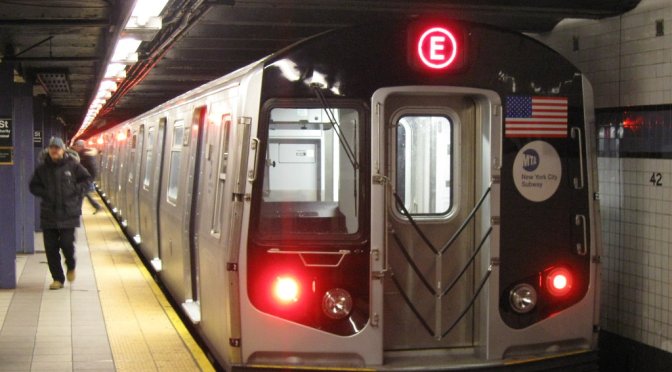My first trip on the New York Subway didn’t go as planned. I found myself on an uptown platform when I intended to go downtown and was confused as to why the train didn’t end up where I expected it to. As such, the subway (already daunting enough to begin with) became seemingly impossible to master. However, through repeated efforts I began to get the hang of one of the most complex transit systems in the world. To that end, I have compiled a guide to the subway in an attempt to educate fellow travellers!
HOW MUCH DOES IT COST?
At present, the fare for a single ride is $2.50. However, through the discounts available for multiple ride combinations, or through using unlimited-ride MetroCards (which are available to be used for set periods), the actual cost can be substantially less. I found the best value for short-term visitors such as myself is a 7-day unlimited pass for $30.
“UPTOWN” AND “DOWNTOWN”
On the subway, the words “uptown” and “downtown” are used in this relative and direction-of-travel way. When used that way, “uptown” means to the NORTH of where you are now standing, and “downtown” means to the SOUTH of where you are now standing. Before you enter the station, you MUST know whether you are going “uptown” or “downtown”.
THE STATION ENTRANCE
At the sidewalk entrance there will be a sign that shows the name of the station and the lines that stop there. Some stations do not have any way to cross between the uptown and downtown platforms, and the station entrance will lead to the platform for one direction of travel only. In such cases, the sign at the entrance will specify which direction can be accessed from that entrance.
WHAT YOU FIND WHEN YOU GO DOWN THE STAIRS
When you enter a subway station, you will arrive in the area with the turnstiles. There is also a large map of the entire subway system on the wall, along with a bus map and a neighborhood map. You will also find machines where you can purchase MetroCard. You can also buy MetroCards from the “railroad clerk” in the booth. If you want your own subway map or bus map, the clerk has these in the booth — they are FREE, so ask for one! If you are from outside the US and are using a machine to purchase or add value to a MetroCard, don’t be perplexed if the machine asks you for your “ZIP code”, which is a 5-digit US postal code. Just enter 00000, and the machine will accept it.
THROUGH THE TURNSTILE AND ONTO THE PLATFORM
Once you have entered the turnstile, you continue to the platform. Keep in mind that some stations are large complexes, and have more platform areas than one – just because you found a platform, it does NOT mean it is the one you are looking for! How do you know what platform it is? Look at the signs that show what lines stop there, and also whether that platform is for “uptown” or “downtown” trains.
ABOUT THOSE LETTERS AND NUMBERS
It is very important that you know the exact name of the line or lines that you want to use; NEVER think of the subway as having a “red line” or a “blue line”. But aren’t the lines shown in those colors on the map? Yes, but the colors do NOT tell you where a train goes, nor do they tell you which stations a train stops at. Two trains that have the same color may end up in entirely different locations, while trains with different colours may make identical stops.
EXPRESS AND LOCAL
The NYC subway has both local trains that stop at every station, and express trains that use a different track and that skip many stations, just stopping at certain major stations. How do you know which is which? Simple: at places and times when express service is in operation (because some express trains go local during very late night hours), a line that runs express on weekdays will ALWAYS be express on weekdays, and a line that runs local on weekdays will ALWAYS be local on weekdays If you know where you are going, whether it is an express or a local stop, and what trains stop at the station to which you are going, you will then know what train or trains you want.
HOW DO I KNOW WHEN TO GET OFF?
While stations are announced, sometimes the public address system does not work well and the announcement may sound like “Mmph whngg grph Bbklyn-bmd drnns wahh bwmmhh”. You should therefore have some idea of what stations come shortly before the one you want, and be watching for your station. Watching? Yes; when the train pulls into the station, you can look out the window and see the name of the station written repeatedly on signs, in the tiles on the station wall, and on plaques attached to the station columns.
BUT WHAT IF I GET LOST?
Well, so what if you do? The trains are all running on fixed rails, and it isn’t as if they are wandering about the countryside to end up in some random and unknown location miles from town. If you miss your stop, it is very clear from the map (remember, there are two maps in every car) what the next stop, and all of the stops after that, will be. Simply get off at the next station where you can cross to the other side and get a train going back in the direction you wanted.
USEFUL LINKS
Here are links subway riders might find useful:
The main page of the MTA:
The map of the subway system:
http://www.mta.info/nyct/maps/submap.htm
Service Advisories:
http://travel.mtanyct.info/serviceadvisory/
Schedules for individual subway lines:
http://www.mta.info/nyct/service/schemain.htm
The Straphanger’s Campaign (a private advocacy group for subway riders)
The Wikipedia entry on the New York City Subway:

